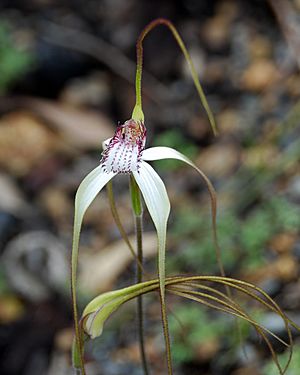White spider orchid facts for kids
Quick facts for kids White spider orchid |
|
|---|---|
 |
|
| Caladenia longicauda subsp. longicauda in John Forrest National Park | |
| Scientific classification |
|
| Kingdom: | Plantae |
| Clade: | Tracheophytes |
| Clade: | Angiosperms |
| Clade: | Monocots |
| Order: | Asparagales |
| Family: | Orchidaceae |
| Subfamily: | Orchidoideae |
| Tribe: | Diurideae |
| Genus: | Caladenia |
| Species: | |
| Subspecies: |
C. l. subsp. longicauda
|
| Trinomial name | |
| Caladenia longicauda subsp. longicauda |
|
The white spider orchid (Caladenia longicauda subsp. longicauda) is a special type of flower found only in the south-west part of Western Australia. It's part of the big Orchid family. This orchid has a single fuzzy leaf and usually grows up to four mostly white flowers. These flowers are unique because their sepals and petals have long, thin, thread-like ends that droop down, making them look a bit like a spider! You can find these beautiful orchids growing in woodlands and forests.
What Does It Look Like?
The white spider orchid is a plant that grows in the ground. It's a perennial, meaning it lives for more than two years, and it's deciduous, so it loses its leaves at certain times. It grows from an underground tuber, which is like a small storage root. Sometimes, you'll see just one plant, but other times, they grow in small groups.
Each orchid has one hairy leaf that is about 18 to 25 centimeters (7 to 10 inches) long and 0.5 to 1.5 centimeters (0.2 to 0.6 inches) wide. It can have up to four mostly white flowers on a stem that stands about 35 to 60 centimeters (14 to 24 inches) tall. These flowers are quite large, about 10 to 15 centimeters (4 to 6 inches) long and 6 to 9 centimeters (2 to 3.5 inches) wide.
The sepals and petals of the flower have long, brown, thread-like tips. The top sepal, called the dorsal sepal, stands straight up. It's about 7 to 11 centimeters (2.8 to 4.3 inches) long. The two side sepals, called lateral sepals, spread out at their bases, but their long tips hang down. They are about 9 to 13 centimeters (3.5 to 5 inches) long. The petals are similar to the side sepals and are about 7.5 to 9 centimeters (3 to 3.5 inches) long.
The most interesting part is the labellum, which is the orchid's special lip. It's white and about 1.7 to 2.4 centimeters (0.7 to 0.9 inches) long. It has erect or spreading "teeth" up to 0.8 centimeters (0.3 inches) long. The very tip of the labellum curls under. In the middle of the labellum, there are four to eight rows of small bumps called calli, which can be white or reddish. The column, which is the central part of the flower, is about 1.8 to 2.2 centimeters (0.7 to 0.9 inches) long. These orchids usually bloom between August and October.
Its Name and Family Tree
The white spider orchid was first officially described in 1840 by a person named John Lindley. He wrote about it in a book called A Sketch of the Vegetation of the Swan River Colony. Later, in 2001, two scientists, Stephen Hopper and Andrew Brown, described eleven different types (subspecies) of this orchid, including the one we call longicauda. They published their findings in a science journal called Nuytsia.
The scientific name longicauda comes from two Latin words: longus, which means "long," and cauda, which means "a tail" or "appendage." This name perfectly describes the long, thin, tail-like ends of the sepals and petals on the flower.
Where Does It Live?
The white spider orchid is quite common in the south-west part of Western Australia. You can find it in the area south of a line drawn between Lancelin and Mount Barker. It grows in different natural areas like the Avon Wheatbelt, Jarrah Forest, Mallee, Swan Coastal Plain, and Warren regions. It prefers to grow in woodlands and forests.
Is It Safe?
The Western Australian Government's Department of Parks and Wildlife has looked at the white spider orchid. They have classified Caladenia longicauda subsp. longicauda as "not threatened." This means it's not currently in danger of disappearing.
See also
 In Spanish: Caladenia longicauda para niños
In Spanish: Caladenia longicauda para niños

